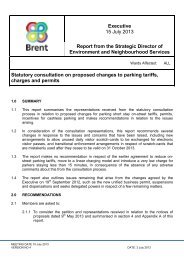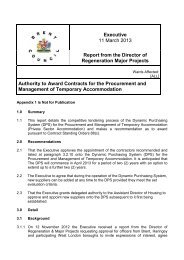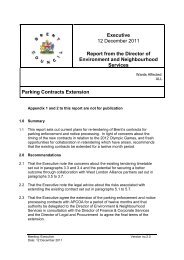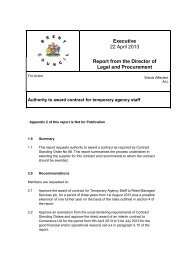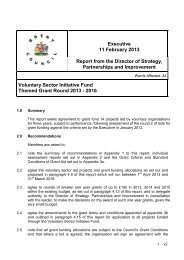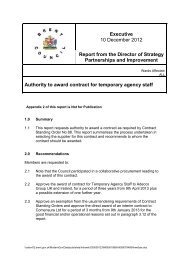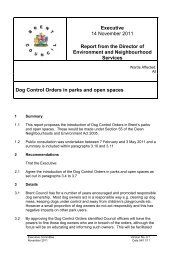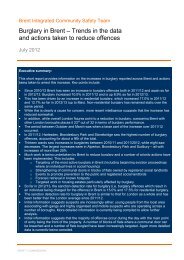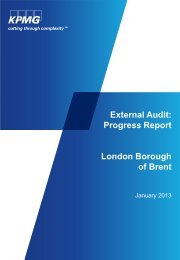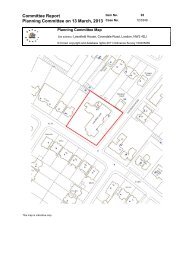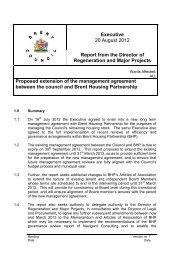wembley-plan-app (small) , item 9. PDF 8 MB - Meetings, agendas ...
wembley-plan-app (small) , item 9. PDF 8 MB - Meetings, agendas ...
wembley-plan-app (small) , item 9. PDF 8 MB - Meetings, agendas ...
- No tags were found...
Create successful ePaper yourself
Turn your PDF publications into a flip-book with our unique Google optimized e-Paper software.
94Wembley Area Action Plan - Proposed Submission Version10 Response to climate changeStrategic Policy10.1 As the scientific understanding of climatechange and its likely impacts become clearer sincethe Kyoto protocol was drawn up in 1997 toimplement the United Nations FrameworkConvention for Climate Change,there have beenvarious international, EU, national, London andlocal climate mitigation targets set to tackle climatechange collectively. The NPPF acknowledges that<strong>plan</strong>ning plays a key role in helping shape placesto secure radical reductions in greenhouse gasemissions, minimising vulnerability and providingresilience to the impacts of climate change, andsupporting the delivery of renewable and lowcarbon energy and associated infrastructure.10.2 UK Climate Projections predict that summeraverage temperatures in London will, given a lowemissions scenario, rise by 1.6˚C over 30 yearsbetween 2010 and 2039, that summer rainfall willdecrease by 7% in 2020 and that winter rainfall willincrease by 6% in the same time period. The mainclimate change impacts on London will beoverheating (urban heat island effect), waterscarcity, increases in the frequency of flooding,severe weather events and more frequent heatwaves. Increasingly it is acknowledged that acertain level of climate change is inevitable anddevelopment will need to be built to cope with achanging climate.10.3 The London Plan sets out a comprehensiverange of policies to underpin London’s response toclimate change. It concludes that the effects ofclimate change could seriously harm Londoners’quality of life, particularly the health and social andeconomic welfare of vulnerable people. TheMayor’s Climate Change Mitigation and EnergyStrategy contains further proposals to reducecarbon dioxide emissions and to tackle climatechange through decarbonising London’s energysupply, reducing the energy consumption ofLondon’s existing building stock and movingtowards zero emission transport in London.10.4 Nearly all residential development will bewithin the Wembley Growth Area where majorresidential proposals are required to achieve aminimum rating of Code for Sustainable HomesLevel 4 in line with policy CP19 of Brent CoreStrategy. A rating of BREEAM “Excellent” isexpected for major non-residential developments.Policy Context10.5 Wembley AAP covers a diverse mix ofresidential, industrial, shopping, leisure,entertainment, community and office land uses infragmented land ownership, such that the areapresents challenges when trying to achieve social,economic and environmental sustainability. Thereare mechanisms to reduce carbon emissions fromnew developments in Wembley through the LondonPlan, UDP and LDF <strong>plan</strong>ning polices, buildingregulations and other initiatives. The first step inreducing carbon emissions from development inWembley is to ensure new development uses lessenergy in line with the Mayor’s energy hierarchy to“be lean, be clean and be green."10.6 Climate change will have a significant impacton the economic, social and environmental wellbeing of Wembley. Hotter summers will have abigger impact in Wembley because of thepredominance of concrete and buildings. Heatwaves will mean more people are likely to sufferfrom illnesses and could also lead to damage toroads, railways and buildings. Heavy thunderstormsand intense winter downpours will become morecommon, and will lead to flash flooding where thedrainage system cannot cope with the increasedrainfall. It is therefore crucial that futuredevelopment in Wembley addresses these impactsand limits its contribution to climate change byminimising carbon emissions.10.7 Specific issues for Wembley include thelegacy of industrial use in the area which led to alack of green and ‘cool’ spaces. Much of Wembleyis deficient in open space and there are few maturetrees. Land adjacent to the Wealdstone Brook ismost at risk of flooding, although much of Wembleyis also prone to surface water flooding. In addition,the majority of the sewer network in the Wembleyarea is undersized.The whole of the AAP area isan Air Quality Management Area (AQMA). Anyproposals for new development will have to complywith London Plan policy 7.14: Improving Air Qualitywhich seeks to minimise increased exposure toexisting poor air quality and make provision toaddress local problems of air quality, particularlywithin AQMAs.



